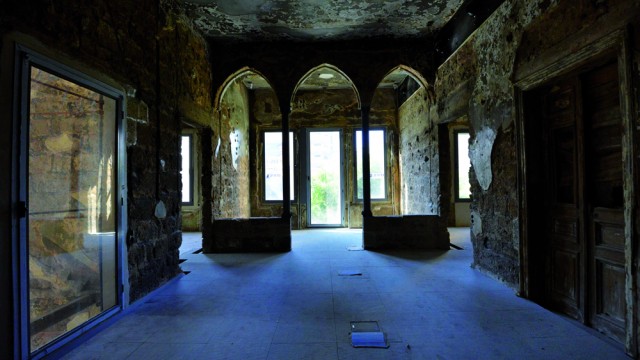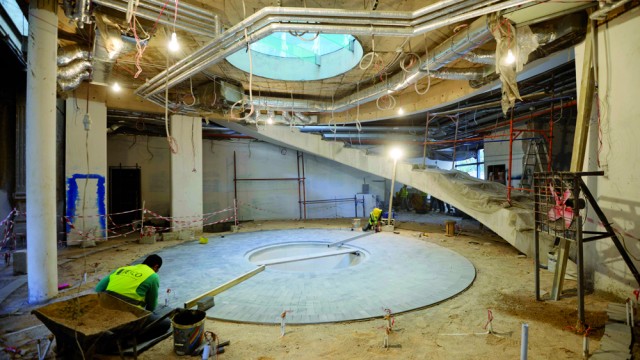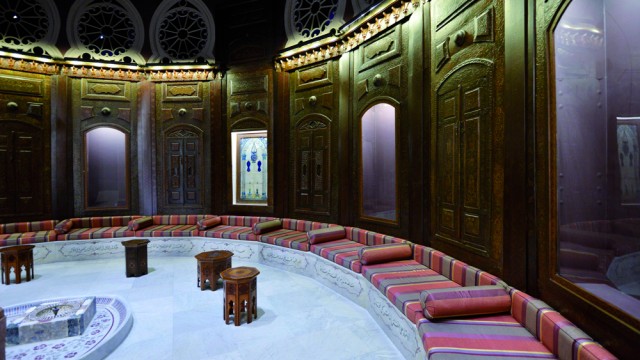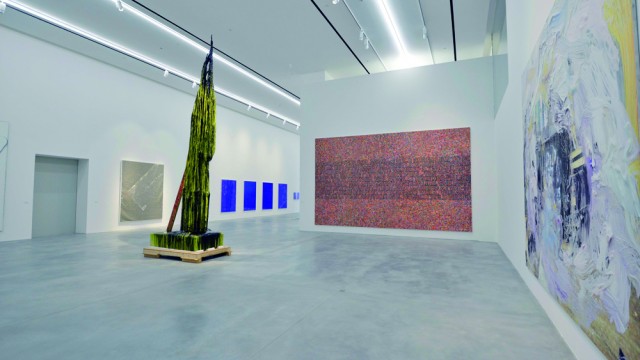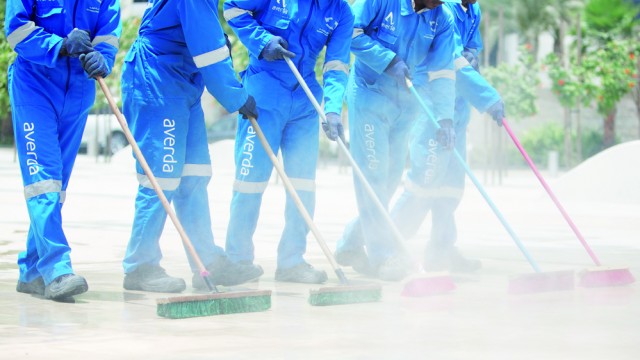![Greg Demarque | Executive]()
Once again this November, the Lebanese autumn sun bathes the front of the Barakat Building in a warm, sleepy glow that accentuates its imperfections and old wounds just as they were inflicted more than a quarter century ago. But the old structure is very much awake. Just around the corner, workers navigate scaffolding on the heritage building’s side and along the new annex that together with the original nonagenarian structure is slated to form Beit Beirut, the house of memory.
A deceptively obvious allusion to the role as house of memory is the reference to memories of the Lebanese conflict, when the building was turned into a militia position overlooking one of the few crossing points of the Green Line that divided East from West between 1975 and 1990. That is why Beit Beirut will, on the exterior, be a memorial to the conflict years. “The façade is a finished façade that we want to maintain as witness of the war, showing Beirutis what they did to their city once upon a time. Learn from it,” pontificates Beirut mayor Bilal Hamad.
The restored building will, in reference to this past, include a sniper’s nest that controlled the nearby crossing between the two parts of the city. But Beit Beirut is not merely aiming to be a museum of the Lebanese war, as some citizens perceive based on the preserved scars and brokenness of the façade. “This will be a beautiful space for Beirut. My dream is that this will be the museum of memory and the first place to visit for anyone coming to see Lebanon,” Hamad says.
He tells Executive that his vision for Beit Beirut is to have it document and represent every part of the city’s past and every civilization that touched the territory, exhibiting official documents and collections of photographs – “every piece of paper from the history of Beirut.” Moreover, the museum shall be a place for collaborative studies of the civilizations that share its history, such as Canaanite, Phoenician and Aramean cultures, and a presentation hub through its auditorium and future programs.
![Greg Demarque | Executive]()
The interior of Beit Beirut, the outside of which is shown in the main image
Yet currently there is a snag regarding Beit Beirut’s programming, beginning with the opening date. Delivery of the structure is overdue by a couple of years; however, this being Beirut and the museum a public sector project, only the opposite would have been a real surprise. What is nonetheless shocking, as per the state of affairs in November 2015, is that the building will be ready for handover by end of the year, Hamad says, but without the benefit of having a plan for either its inauguration or programming and operations.
He puts the blame for this failure at the door of the Beirut governorate, claiming that an agreement with a heritage consulting firm for devising the Beit Beirut program could not be formalized because the governor had not yet signed off on it. “I am almost finishing the construction and I don’t have a program on how to inaugurate the building and how to run the building. I have no idea. We will have concrete, stone and masonry and it will be an empty place because the governor is taking so much time to act on this matter,” Hamad laments.
Despite the Byzantine plays that seem to perpetuate themselves effortlessly in any Lebanese governance endeavor, it is worth talking about the positive sides of seeing this new museum completed, a public space in a city that is being increasingly overbuilt with monuments to private ownership. It is widely acknowledged that, once operational – hopefully within 2016 – Beit Beirut will be a cornerstone in the cultural identity of the Lebanese capital. It also deserves to be noted that this vestige of the Lebanese dream from the nascence of national statehood has every potential to be a pillar of the urban economy.
The road to hard cultural assets
The pillar in question is the economy of culture. This is something notoriously difficult to assess and almost impossible to quantify in any country (see culture economy). But worse for the economic potency of Lebanese culture is the impression of devaluation forced upon any serious observer by the recent years of careless treatment of many heritage-status deserving buildings and of fruitless protests against destruction of antique sites. Even the fact that activists saved Beit Beirut from demolition in the late 1990s is testimony to the sad truth that both the preservation and the sustainable exploitation of historic cultural assets in the city of Beirut have been dismal.
This impression of severe economic under-appreciation of cultural assets is reinforced just a few blocks up on Damascus Street, at the National Museum. The epitome of Lebanon’s modern history in its own right, having also stood on the Green Line, the National Museum recently recorded visitor numbers of fewer than 30,000 persons – per year. Some specialized history and archeology treasuries elsewhere in the Mediterranean count twice that number per week, or at least several hundred thousand visitors each year. These museums, moreover, do not have the same stories to tell as the Lebanese National Museum, and their collections are not necessarily as splendid.
![Despite its appearance, Beit Beirut is nearly ready to open]()
Despite its appearance, Beit Beirut is nearly ready to open
The observation of underperforming culture is not to insinuate in any way that culture and Beirut have been disassociated in the past or present. It is to say that the continuity of arts and culture in the history of this speck of sometimes troubled Eastern Mediterranean beauty is all too often neglected when compared with popular emphases on the comparatively short but painful conflict periods that comprised the Lebanese Civil War. There are similar emphases on present-day incidents that have led to mistaken characterizations of Beirut as a place with isolated occurrences of beauty and art in an overall dominant state of turmoil.
In that context, it is good news that at least in a manner of perceptions, museum inaugurations in 2015 were beating other high-profile developments of spaces for public leisure hands down, winning out spectacularly over retail space launches and hotel openings, for example.
In early October 2015, it was the reopening of Beirut’s historically most important art space, Sursock Museum, that drew the city’s cultured class onto the lawn in front of the concrete structure’s neo-Moorish, palatial façade. Speeches were given, arias sung and champagne glasses raised in congratulations. The exercise seemed to resonate and another museum inauguration spectacle vied for attention merely two weeks later in the highly-touted opening of the Aïshti Foundation’s art exhibition space along the northern coastline of metro Beirut.
Prospering plans
Plus, the cultural buzz of late was not only about museum openings. While caterers were still passing around the champagne flutes at the high-society laden Aïshti Foundation opening, laborers were already putting up the construction fence for an archeological excavation in preparation for a large new museum project in the center of the Lebanese capital, at the northern end of Martyrs’ Square. According to Mayor Hamad, work on the Beirut History Museum is finally starting at the location where Lebanon’s Phoenician, crusader and Ottoman past intersect with the Lebanese people’s current strife for true independence and proper governance.
At another downtown spot, currently a parking lot that briefly served as a drive-in open-air cinema at the end of the 1990s, yet another prestige museum should be on its way. This one is set to receive monetary help from the Sultanate of Oman (while Kuwait is the financing partner of the History Museum project). Its working title is House of Arts and Culture, or Dar Beirut. An initial architectural design contest for the project was staged over six years ago and winning results were announced in March 2009.
The snag in realizing the museum is that the Lebanese state did not come to an agreement with the site’s owner, Solidere, Hamad says. “At the time when Fouad Siniora was Lebanon’s prime minister, Oman committed to giving $20 million for the construction of a cultural center, but on the condition that the Lebanese government would provide the land,” he explains, adding that the negotiations did not reach fruition until the Beirut Municipality recently agreed to step in as buyer of the designated plot. According to Hamad, the municipality and the Ministry of Culture are now jointly progressing in negotiations with Solidere over the land acquisition as precondition for developing this cultural asset.
In addition to the two publicly driven projects with foreign funding in central Beirut, a third major museum project is being pursued in a private sector/civil society initiative by an organization called APEAL, the Association for the Promotion and Exhibition of the Arts in Lebanon. For this project, a plot owned by the University of Saint Joseph has been earmarked in a very attractive location across from the National Museum of Lebanon. The idea is to create a museum for modern and contemporary art by the year 2020, and an architecture design competition for the project was launched in the fourth quarter of 2015.
![The Sursock Museum has been renovated and opened to the public]()
The Sursock Museum has been renovated and opened to the public
APEAL would not provide Executive with budget projections and fundraising targets for either the architecture competition or the museum project itself but made it clear that it will rely on in-kind contributions and private sector donors. “As this initiative aims to develop a civic institution in Lebanon, and in the absence of public funding, APEAL is seeking in-kind contributions for various aspects of the project development,” explains Rita Nammour, the association’s president.
Besides seeking design entries where architects are willing to work under a formula in which “fees, overhead and direct staff will be compensated at a determined amount in lieu of standard fees and will reflect remuneration in line with a non-profit venture,” the project, according to Nammour, relies on the Lebanese cultural community, members of the diaspora and art patrons. “For a project as thoughtful and long-term in its approach as the museum we are building, it is absolutely essential to have such committed support from the diverse communities across Lebanon,” she says.
If one chooses to view the future of Beirut as cultural epitome in terms of economic assets, then these three projects alone suggest that the urban balance sheet of museums as property assets will increase multiple times over the coming four to seven years. Given the locations and potential dimensions of the Beirut History Museum, Dar Beirut and the Modern and Contemporary Art Museum projects, it is safe to expect that the urban investments into art and culture spaces will exceed the approximate $40 million-plus amounts that have been dedicated to the two recently opened spaces, Sursock and Aïshti Foundation, and to Beit Beirut.
The property values of the three recent museums cannot be appraised precisely because Sursock Museum was an existing public property and because the plot for Beit Beirut was purchased at, by today’s standards, a supreme bargain for $2.8 million back in 2002 before land prices in the Lebanese capital exploded. However, the invested amounts in public funding for the Sursock Museum expansion and Beit Beirut inside-out conversion were significant enough, at $12 million and $19.8 million according to Mayor Hamad. In the absence of clearer data from the owners, it would also be hazardous to guess how much of the $100 million investment into the Aïshti Foundation building exactly went into the museum space there, given that 90 percent of the property’s 40,000 square meters in built-up area are consumed by commercial retail and hospitality.
Constructing an economy of culture
Even with those caveats on the exact values of these three cultural assets at end 2015 and the notorious question marks over achievability of intended project delivery dates in Lebanon, it is a reasonable expectation that by the completion of the three aforementioned projects that are currently in the planning or pre-excavation phase, the six museums alone will five or ten years down the road represent cultural assets worth far north of $100 million.
It should be noted that many museums on our Beirut cultural map have either been newly established since 2006 – e.g. the two AUB art museums, the Beirut Art Center, the Beirut Exhibition Center, the MIM mineral museum and the Robert Mouawad Private Museum – or were significantly restructured and upgraded in the past 10 years. When adding this to the tally of asset valuation, it appears that the metropolitan area is well on its way to being transformed from a museal void to becoming a museum hub.
Can these museums provide a boost to the Lebanese economy? The answer is a multi-layered one, but the immediate business and job generation opportunity will involve leisure explorers of culture. Over the past 25 years, concepts of cultural tourism development have been presenting themselves time and again as natural opportunities to Lebanon, but have been equally often relegated to economic insignificance by the political impossibility to organize safe and easy tours in the countries of the Fertile Crescent.
Due to the region’s latest laments, that impossibility is today greater than at any previous time in the past 25 years. However, a new alternative to combining cultural excursions to Lebanon with travels in the Levant could lie in a Mediterranean exploration paradigm. As Tourism Minister Michel Pharaon tells Executive, Lebanon sees an important future revenue driver in the Phoenician Route project of Mediterranean culture tourism that he says will be developed over the coming years.
“The Phoenician Route resembles the Silk Road and it is a project that is going to be taken care of directly by the UN World Tourism Organization (UNWTO). It is culture that is turned into tourism products. It will take a few years, like the Silk Road which took almost ten years to develop, but it is on the map today,” Pharaon says. According to him, three countries will be steering the Phoenician Route, namely Spain, Tunisia and Lebanon, and the project is on the agenda for a meeting in May 2016 that the UNWTO’s Middle East committee, which is currently being chaired by Lebanon, will convene in Beirut.
Cultural tourism, which is as old as human curiosity to learn about civilizations other than one’s own, can certainly generate revenues for Lebanon and do so all the more thanks to the expansion of high-profile museum assets in Beirut and other potential developments under discussion with ministries and international conservation bodies, such as improved preservation and accessibility of Lebanon’s many diverse sites of archeological, historic and religious interest.
A broader angle yet
However, even a sweeping view of history and cultures from the Phoenician all the way to the Ottoman and French Mandate eras cannot and should not be taken as the whole perspective. Focusing solely on sites and witnesses of historic civilizations could be even counterproductive for realizing Lebanon’s potential from the perspective of an economy of culture. The simple reason for this is Lebanon’s extraordinary vitality in producing and hosting the arts today, which to ignore would mean crippling the growth of this economy.
What is deserving of real fascination in this context is not the growing number of museums or the value of their collections – immeasurable as they are – but their quality and diversity. A journey through the museums and art exhibition spaces of Beirut today confirms this with gusto: the arts, alongside trade skills and the will to survive, are the real constant of Lebanese identity.
From the prehistoric jars and bronze-age statuettes over the Hellenistic sarcophagi, early Christian mosaics and Islamic pottery, to the collections of paintings and photographs from the late 1800s onward up to 20th century jewelry, or the latest disruptive installations by young Lebanese and resident or visiting foreign artists and designers, one only has to keep her or his eyes open when wandering between its museums and the city to see that Beirut is not primarily filled with testimonies to stupid greed (although they too exist aplenty), but with evidence of both creative minds and collectors of all things beautiful.
The creative treasures and the collected ones are becoming well represented in Beirut’s widening range of museums, from the archeology museum at the American University of Beirut and the National Museum to the contemporary art spaces in the comparatively cramped and unassuming but inspirational Beirut Art Center and the Aïshti Foundation’s magnificent four floors of perfectly designed exhibition area.
![Beirut's newly opened Aishti Foundation]()
Beirut’s newly opened Aïshti Foundation
Perpetuating a creative environment and democratizing access to art is what previously no museum of major size and capacity has been able to provide in Beirut. This is what APEAL aims to produce through their planned Modern and Contemporary Art Museum. “The idea is to help Beirut in developing a museum-going culture not in an elite segment of the city or the society but through a museum that reaches out to the communities, with events tailored to the mission. We want it to be a kind of house of the people but we also are striving for it to be first rate, on a par with great museums of the world,” says Nora Boustany, board member of APEAL who describes herself as the organization’s philosophical or abstract mind when compared with the business expertise of the other board members.
According to Boustany, the museum will seek to showcase above all young Lebanese talent, alongside artists from the region, some of whom cannot hope to see museums being realized in their home countries.
Pointing to the planned museum’s location that is highly accessible in a geographic as well as social sense from all urban and rural quarters of Lebanon, Boustany tells Executive that the new museum’s mission will include outreach events in rural areas such as the Chouf or the far north of Lebanon. ”We will try to help reel people into the idea of appreciating art. We are going to storm the local communities through visiting arrangements with elementary schools and secondary schools in the countryside and in the cities. And we are not talking about elites. Our target audience is everybody, art connoisseurs and the general public,” she emphasizes.
In its own brand of political awareness targets, the vision of APEAL extends to countering the culture of death that the terror organization ISIS is seeking to push. “We want to run with the young people in the opposite direction and we want the Lebanese and the Arab citizens to reconnect with their humanity, to have a much more serene, esthetic, balanced and spiritual vision of who they are and where they want to go,” she says.
Cognizant that the project in all its cultural aspirations will have to be economically viable, she points out that the museum and the museum-going culture that APEAL seeks to foster will generate jobs for many talented and university-trained young Lebanese who continue to lack opportunities to earn their living as culture workers in Beirut. The museum project itself is being prepared with the help of professionals who work on the budget and APEAL board members who are top consultants and help with strategizing. She concludes, “It will be a challenge, but the Lebanese have made so many institutions and corporations a success that I don’t see how a collaboration of local talents and knowhow and corporate muscle and backing cannot produce something that is economically viable.”
All that professional effort and enthusiasm may very well contribute to anchoring a socially rich and materially satisfying economy of culture in Lebanon and Beirut. But it is the owner of a dukkaneh at the top of Rue Monot who testifies to the tangible business potential underneath all the complicated babble. “I hope the museum opens soon,” he says, pointing at Beit Beirut across the narrow street. “It will be good for me.”
The post A city and its art appeared first on Executive Magazine.






